
















Please login here to save this document to a list.
If you don't have an account, you can register for free here.
Computer Industry Analysis Training (PowerPoint PPT Slide Deck)
PowerPoint (PPT) 91 Slides
STRATEGIC PLAN EXAMPLE PPT DESCRIPTION
This presentation is developed by a leading consulting firm on the computer industry dynamics. The data in the document is a bit outdated but the document provides an excellent example of what the key elements of an industry analysis are and how some key framework and concepts are applied in such an analysis. Many slides in the presentation are re-useable in other consulting projects.
This comprehensive presentation delves into the critical aspects of the computer industry, offering a granular view of market dynamics and trends. It highlights the persistent decline in average selling prices across PCs, servers, and mainframe servers, emphasizing the industry's shift towards cost-effective distribution models and efficient manufacturing processes. This document is a valuable resource for understanding the economic forces shaping the computer market.
The analysis extends to market segmentation and vendor share, revealing the fragmentation in the PC segment and the dominance of large manufacturers in the server and mainframe markets. It also explores the strategic moves of key players like Gateway, which aims to generate significant profits from services beyond hardware sales. This insight is crucial for executives looking to navigate the competitive landscape.
A detailed comparison of indirect versus direct channel economics provides a clear understanding of the cost structures and profit margins associated with different sales strategies. The document outlines Dell's successful approach to building a direct channel, focusing on key value-chain elements such as assembly, order fulfillment, and up-front order management. This case study serves as a benchmark for companies aiming to optimize their distribution channels.
The presentation also addresses the disruptive changes enabling the growth of information appliances and services. It examines new technologies, business models, and consumer behaviors that are driving the deployment of smart devices and personalized services. This forward-looking analysis is essential for executives planning to capitalize on emerging opportunities in the digital lifestyle market.
Got a question about the product? Email us at support@flevy.com or ask the author directly by using the "Ask the Author a Question" form. If you cannot view the preview above this document description, go here to view the large preview instead.
Source: Best Practices in Strategic Plan Example, Industry Analysis, Environmental Analysis PowerPoint Slides: Computer Industry Analysis Training PowerPoint (PPT) Presentation Slide Deck, Documents & Files
STRATEGIC PLAN EXAMPLE PPT SLIDES
Emerging Appliance Categories and Their Functionalities
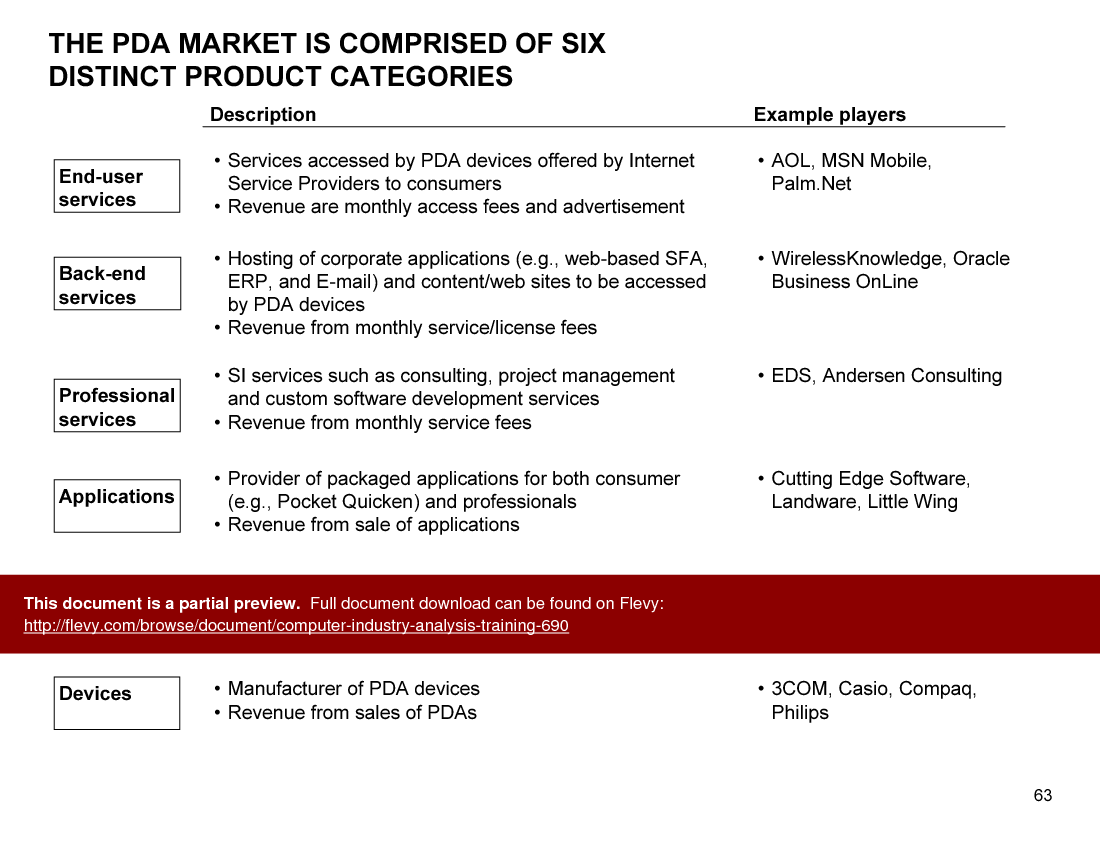
This PPT slide outlines the emerging categories of new appliances, emphasizing 3 primary functionalities: entertainment, information, and communication. Each category is defined by its core function, the services it offers, and examples of existing or potential products.
Entertainment appliances focus on enhancing user experience through broadband access to audio and video streams. They allow for local customization and programmability, which is crucial for meeting diverse consumer preferences. Services listed include video on demand and personalized TV options, with examples like Replay/TiVo and Internet Gaming Stations illustrating the practical applications of this technology.
Information appliances are designed to facilitate the downloading of news and relevant information. They emphasize local caching, filtering, and access, which are essential for users seeking timely updates. The services provided include news, weather, and e-commerce, with products such as WebPad and E-book serving as examples of how these functionalities can be realized in the market.
Communication appliances aim to streamline voice, video, and email communication through home gateways. This category highlights the growing demand for integrated communication solutions. Services like internet telephony and video conferencing are becoming increasingly vital, with examples such as Palm 7 and various e-mail appliances showcasing the potential for innovation in this space.
Overall, the slide effectively categorizes the evolving landscape of appliances, illustrating how they cluster around these functionalities. This framework can guide strategic decisions for stakeholders looking to invest in or develop products within these domains. Understanding these clusters is critical for aligning product offerings with consumer needs and market trends.
Comparison of Storage Architectures: Traditional, SAN, NAS
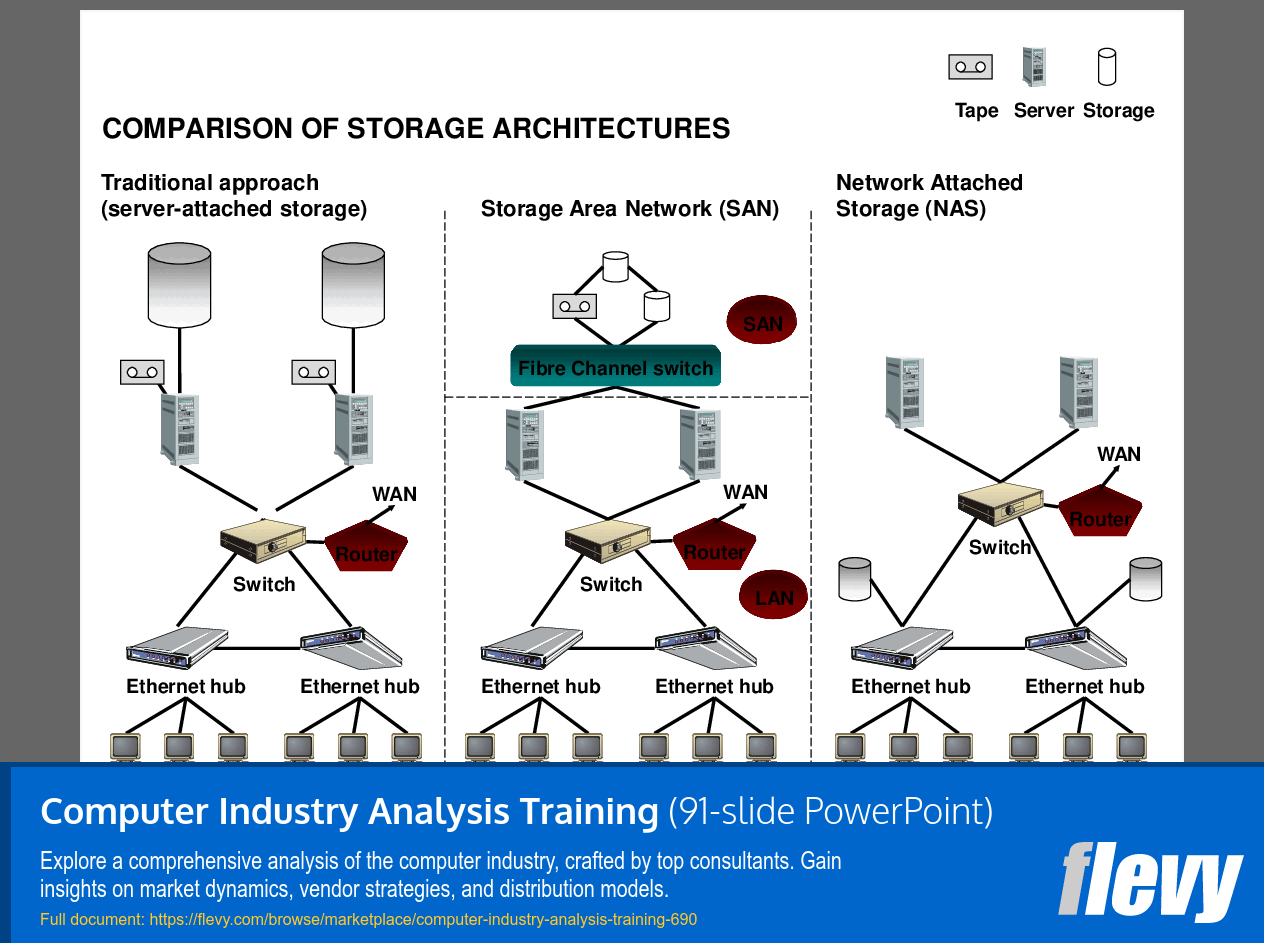
This PPT slide presents a comparative analysis of 3 distinct storage architectures: Traditional (server-attached storage), Storage Area Network (SAN), and Network Attached Storage (NAS). Each architecture is visually represented, highlighting their structural differences and key components.
In the traditional approach, storage is directly attached to servers, which can limit scalability and flexibility. This model typically involves a straightforward setup with servers connected to storage devices via a switch. The diagram indicates the use of WAN and Ethernet hubs, suggesting a more localized network structure that may not efficiently handle large data volumes.
The SAN model introduces a more sophisticated architecture. It employs a Fibre Channel switch, which allows multiple servers to access a shared pool of storage. This design enhances performance and scalability, making it suitable for environments with high data demands. The SAN configuration is depicted with connections to both WAN and LAN, indicating its capability to manage data across broader networks.
On the other hand, NAS offers a different approach by connecting storage devices directly to a network. This architecture is designed for ease of access and file sharing among multiple users. The slide illustrates how NAS integrates with existing network infrastructure, utilizing routers and switches to facilitate data flow.
Overall, the slide effectively outlines the strengths and weaknesses of each storage architecture, providing valuable insights for decision-makers considering their storage options. Understanding these differences can guide organizations in selecting the right solution based on their specific needs and growth projections.
Revenue Trends: Traditional vs. Emerging Computer Segments

This PPT slide presents a comparative analysis of revenue growth in the computer systems sector from 1999 to 2003, highlighting a notable divergence between traditional segments and emerging categories. The left side focuses on the revenue figures for various computer systems, including PCs, servers, and storage systems. The data indicates that while the overall revenue for computer systems grew from $312 billion in 1999 to $401 billion in 2003, the growth rate for traditional segments like PCs and servers has been relatively stagnant, with a compound annual growth rate (CAGR) of only 7.0% for both periods.
On the right side, the analysis incorporates new segments that have significantly boosted revenue growth. The introduction of categories such as smart handhelds and other appliance servers has resulted in a much higher CAGR of 9.7% when these new segments are included. Notably, the "Other Appliance servers" category shows an extraordinary CAGR of 83.4%, suggesting that innovation in product offerings is a key driver for revenue enhancement.
The slide effectively illustrates that while traditional segments are experiencing lackluster growth, the integration of new technologies and market segments is essential for overall revenue improvement. This insight is critical for stakeholders looking to navigate the evolving landscape of the computer industry. Companies must consider diversifying their portfolios and investing in emerging technologies to capitalize on these growth opportunities.
Market Growth Analysis for Vertical PDA Solutions
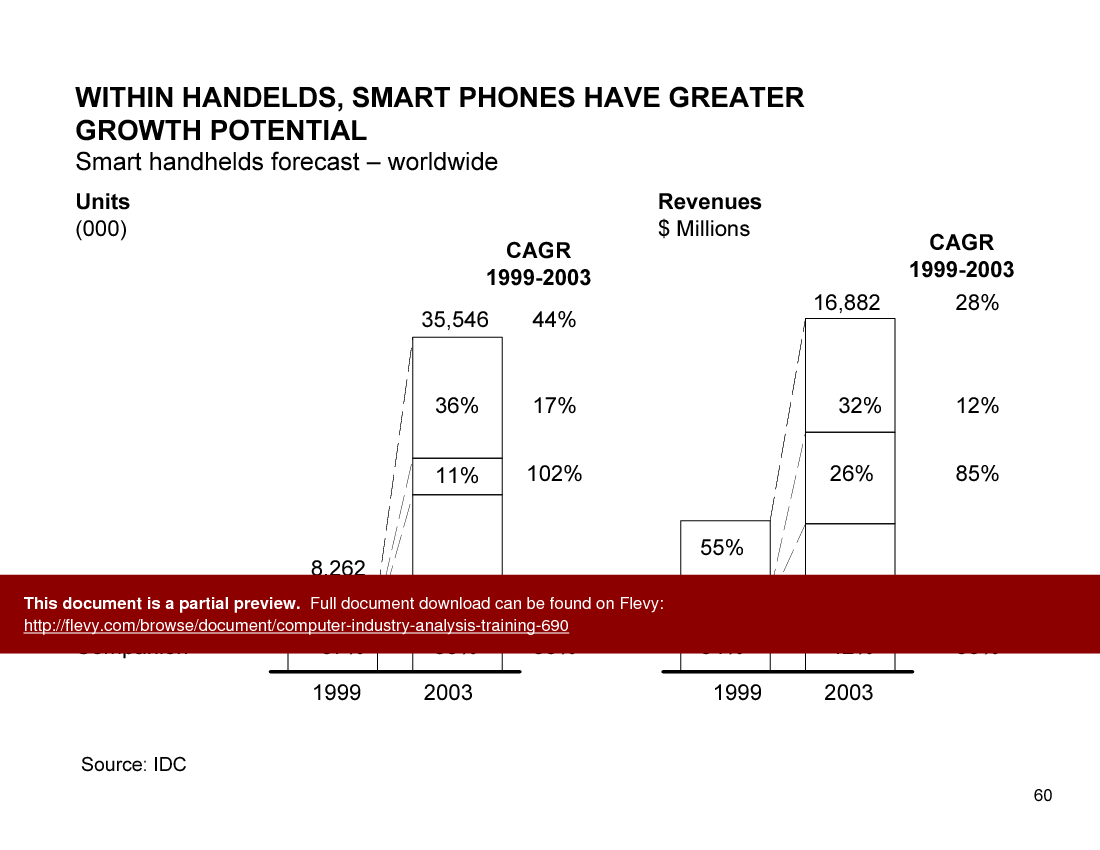
This PPT slide presents a compelling overview of the vertical PDA solutions market, highlighting the estimated device shipments from 1998 to 2003. The data shows a clear upward trend in device shipments, with significant growth from 250 thousand units in 1998 to an impressive 1,850 thousand units in 2003. This growth trajectory indicates a compound annual growth rate (CAGR) of 65% during the specified period, underscoring the increasing demand for these devices.
Key drivers of this growth are identified, including ERP systems, materials management, sales automation, finance, healthcare, and manufacturing. These sectors are likely leveraging PDA solutions to enhance operational efficiency and streamline processes. The mention of these specific industries suggests that potential customers should consider how their own operations might benefit from similar technologies.
The slide also notes a growing need for productive mobile solutions, which is driving strong PDA growth and adoption within the corporate market. This insight points to a broader trend where businesses are increasingly recognizing the importance of mobility in their operations. The projection of an increase in installed base penetration from 6% in 2003 to 12% in 2005 further emphasizes the anticipated expansion of this market.
Overall, the slide serves as a valuable resource for stakeholders considering investment in PDA solutions, illustrating not only the current market potential, but also the underlying factors contributing to this growth. Understanding these dynamics can aid in making informed decisions regarding technology adoption and strategic planning.
Historical Overview of Enterprise Storage Evolution
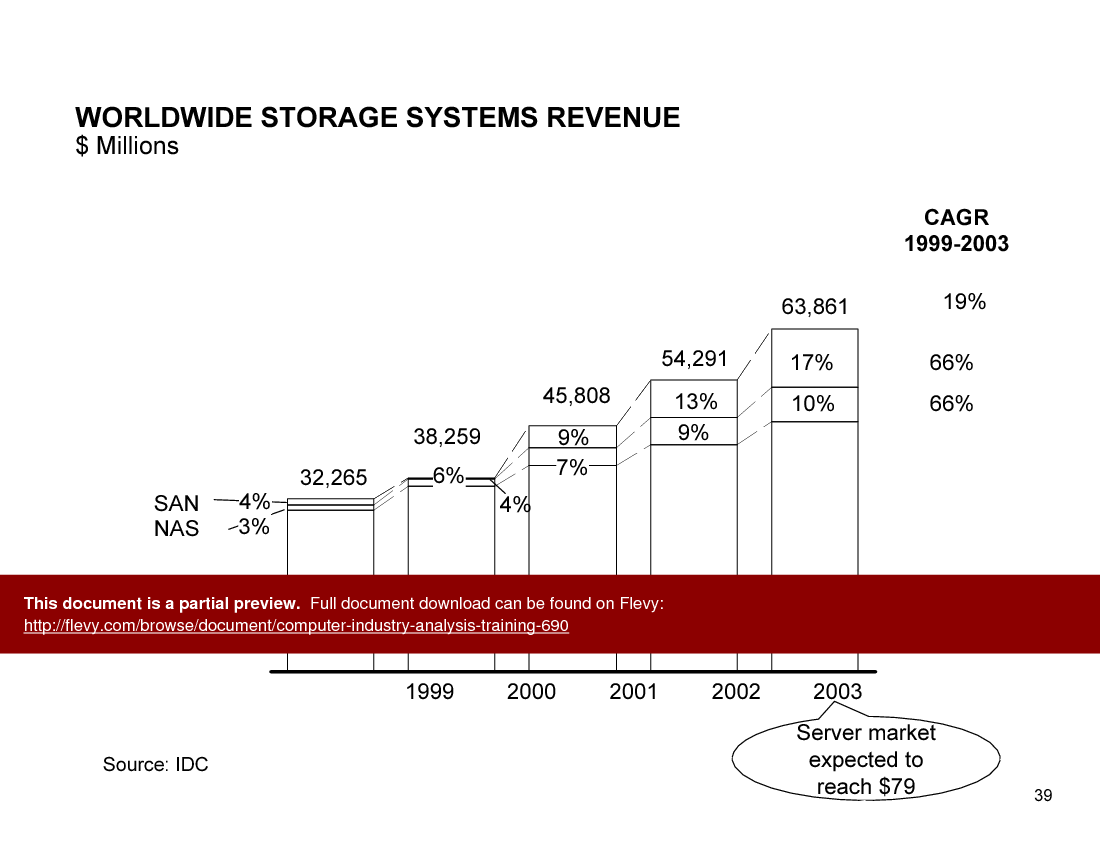
This PPT slide outlines the evolution of enterprise storage from 1965 to the present, segmented into 4 distinct phases. Each phase highlights key developments in storage sales, market dynamics, and the dominant computing environments of the time.
In the first phase, from 1965 to 1991, storage sales were tightly coupled with high-end system sales. This approach created captive markets for large system vendors, primarily dominated by mainframe computing. The focus was on integrated solutions, which limited competition and innovation in the storage market.
The second phase, spanning 1991 to 1996, marks a significant shift as EMC disrupts the status quo. By breaking into the high-end market, EMC rapidly gains market share, indicating a transition towards more open market dynamics. The computing environment remains largely mainframe and Unix-based,, but the emergence of new players begins to reshape the landscape.
From 1997 to 2001, the emergence of distributed computing at the enterprise level fuels the growth of server-attached storage. This phase creates new captive markets for server companies, reflecting a shift towards more decentralized storage solutions. The dominant computing environments evolve to include Unix and NT systems, indicating a diversification in technology stacks.
The final phase, starting in 2001, addresses the need for more efficient storage solutions in distributed environments. This leads to the rise of Storage Area Networks (SAN), which break away from traditional captive storage markets. The focus here is on optimizing storage efficiency and effectiveness, catering to the growing demands of modern enterprises.
Overall, this slide provides a concise historical perspective on how enterprise storage has evolved, highlighting critical shifts in market dynamics and technology adoption.
Driving Forces Behind Increased Data Storage Needs

This PPT slide outlines various emerging applications and technologies that are driving an increased need for data storage and information management. At the center, the phrase "Increased demand for data storage and information management" highlights the core theme. Surrounding this central idea are multiple arrows pointing to specific technologies and applications, each contributing to the growing demand for storage solutions.
Key areas identified include Internet content, e-commerce, and increased bandwidth, which suggest a shift towards more data-intensive online activities. Wireless services and handheld computing are also noted, indicating a trend towards mobile and flexible access to information. The inclusion of electronic books and digital music over the Internet (MP3) points to the changing nature of content consumption, where digital formats are becoming prevalent.
Other factors such as network computing, intranet systems, and electronic appliances suggest a broader integration of technology in business operations. Y2K testing, while historically significant, serves as a reminder of the ongoing need for robust data management practices in the face of technological change. Internet telephony and digital photography further illustrate the diverse applications that require substantial storage capabilities.
This slide serves as a strategic reminder for organizations to evaluate their data storage solutions in light of these evolving technologies. The interconnectedness of these applications emphasizes the necessity for scalable and efficient storage systems to support future growth. Understanding these trends can help organizations make informed decisions about their data management strategies.
Operational Efficiency and Inventory Management Insights

This PPT slide presents a comparative analysis of operational expenditures (OPEX) and inventory levels among key vendors in the computer industry from 1996 to 1999. The left graph illustrates OPEX as a percentage of sales for 5 companies: Apple, Compaq, Micron, Gateway, and Dell. Notably, Dell consistently maintains the lowest OPEX percentage, indicating a more efficient cost structure compared to its competitors. This suggests that Dell's operational efficiency may contribute to its overall financial health and market positioning.
The right graph focuses on inventory levels, measured in days of inventory, for the same vendors. Dell again shows a favorable position with significantly lower inventory days compared to its peers. This lower inventory level can imply better inventory management practices and a more responsive supply chain, which are critical in a fast-paced technology market.
The text in the center emphasizes that while Dell's advantages may be challenged by indirect competitors, the direct sales model it employs provides inherent benefits that are unlikely to be fully diminished. This highlights the importance of operational strategies in sustaining market presence and profitability.
Overall, the data underscores Dell's strategic focus on minimizing operational costs and inventory levels, which are vital for maintaining a robust market position. For potential customers, this slide illustrates the effectiveness of Dell's operational strategies and their implications for long-term sustainability in a competitive environment.
Framework for Industry Standards and Associations
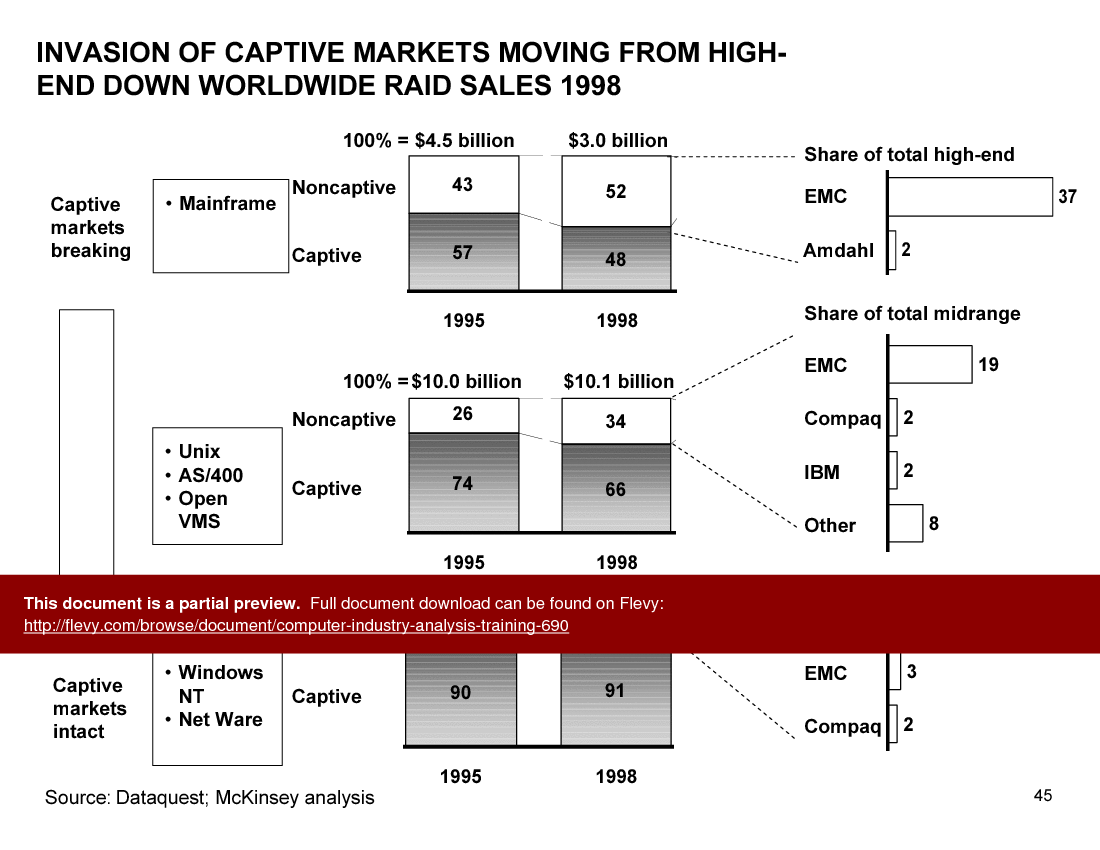
This PPT slide titled "Understanding the Standards Battle" presents a hierarchical framework that outlines the various organizations and associations involved in setting industry standards within the computer sector. At the top of the structure, the Internet Engineering Task Force (IETF) and the Storage Networking Industry Association (SNIA) are identified as key players. These entities serve as trade and industry-wide associations, respectively, indicating their roles in guiding and influencing standardization efforts.
Beneath SNIA, the slide illustrates a branching structure that includes several groups and organizations. The Fibre Alliance and StoreX are positioned as significant industry coalitions, likely focused on specific technological areas or market segments. This suggests that collaboration among these groups is essential for developing and promoting standards that can be widely adopted.
The slide further delineates vendor-led initiatives, highlighting companies like EMC, various software players, Sun, and others. This indicates that individual vendors are also actively engaged in the standards-setting process, possibly to align their products with emerging norms or to influence the direction of industry standards to benefit their offerings.
The flow of recommendations is indicated by an upward arrow, suggesting that insights and guidelines may originate from the bottom tiers of this hierarchy and ascend to the top. This structure implies a dynamic interplay between different levels of organizations, where individual players contribute to broader industry standards.
Overall, this slide serves as a valuable reference for understanding the complex relationships and influences at play in the standards-setting arena of the computer industry. It highlights the importance of collaboration among various stakeholders to ensure that standards are effectively developed and adopted across the sector.
Strategic Framework for Competitive Positioning in Tech
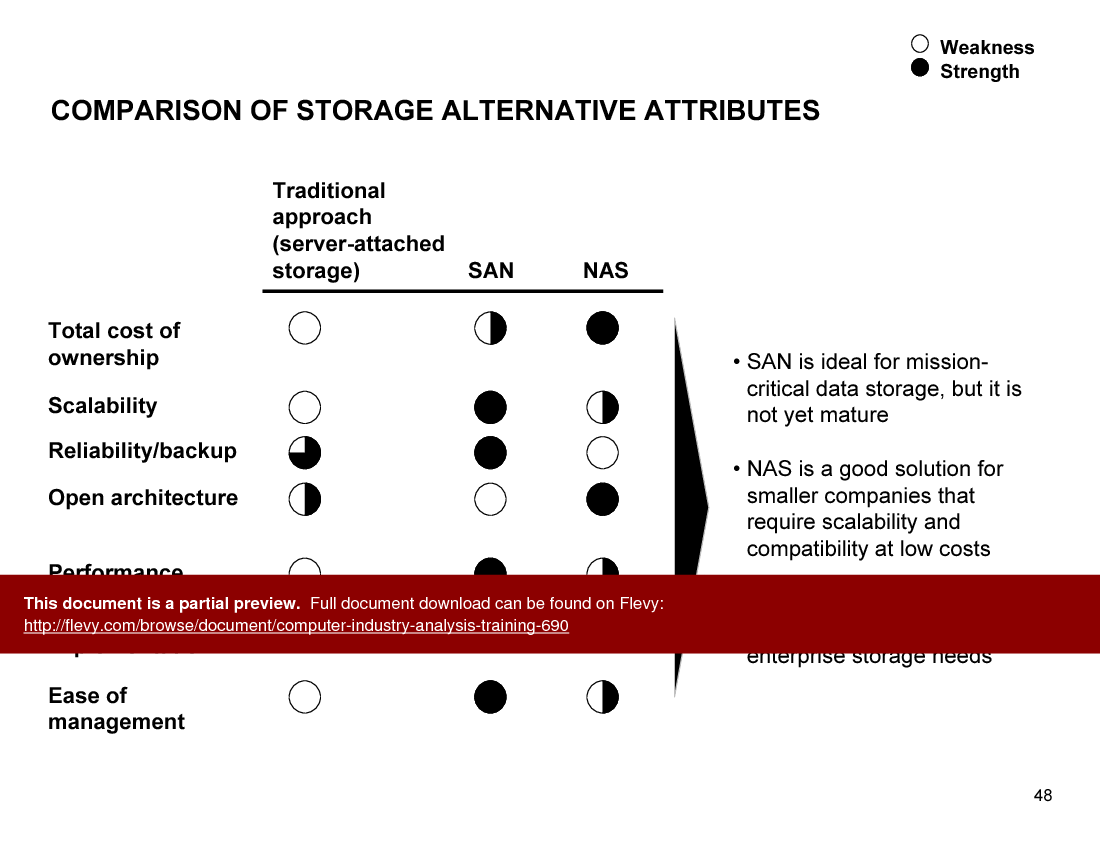
This PPT slide presents a strategic framework that correlates competitive positioning with corresponding strategies within the computer industry. It is structured as a two-dimensional matrix, with the vertical axis representing "Enterprise market power," which encompasses market share and reputation, while the horizontal axis delineates various strategic approaches.
At the top right, the "Storage giant" category features EMC, indicating a high competitive position. The strategy for this segment is labeled "Power play," emphasizing the need to leverage enterprise storage market power to dominate the Storage Area Network (SAN) space. This suggests a focus on market leadership and innovation to shape the web landscape.
The lower sections of the matrix categorize "Server companies" and "Software and connectivity players," which include notable names like Compaq, IBM, and Veritas. These companies occupy a lower competitive position, and their strategies vary. For server companies, the strategy is less defined, suggesting a need for adaptation and potentially a reactive approach to market changes.
"Software and connectivity players" are advised to adopt a "No-man's land" strategy, which implies a need to act as a web influencer or fast follower. This indicates that these companies should focus on leveraging existing hardware capabilities to establish themselves as premier solution providers.
The slide concludes with a section labeled "Technology play," which encourages companies to develop technology at critical architectural points. This highlights the importance of innovation in maintaining a competitive edge, particularly for those aiming to become the "Intel" of SAN technology.
Overall, the slide serves as a strategic guide for executives to align their business strategies with their competitive positioning in the market.
Gateway's Strategy for Recurring Revenue Diversification

This PPT slide outlines Gateway's strategic approach to diversifying its revenue streams, particularly focusing on recurring revenue models. At the center, "Gateway Direct Consumer PCs" serves as the core offering, indicating a commitment to the direct consumer market. Surrounding this core are various initiatives and partnerships that enhance Gateway's service offerings.
Gateway is highlighted as an ISP and portal, suggesting a dual role in providing internet services while also serving as a gateway to additional content and services. This positioning likely aims to create a steady stream of subscription-based revenue from users accessing the internet through Gateway's platform.
The partnership with AOL is significant, as it emphasizes collaboration on non-PC web access devices and broadband initiatives. This suggests that Gateway is not only focusing on traditional PCs, but also exploring emerging technologies and platforms, which could lead to new revenue opportunities. The mention of the Transmeta chip and Netscape Gecko browser indicates a forward-thinking approach, aligning with trends in internet access and device usage.
The slide also references the Verio Alliance, which encompasses web hosting, DSL services, data storage, and e-commerce. This alliance broadens Gateway's service portfolio, potentially attracting a wider customer base and fostering recurring revenue through ongoing service subscriptions.
The inclusion of a "Country store" indicates a physical retail presence, which may serve as both a sales channel and a training facility for customers, particularly small office/home office (Soho) consumers. Financing options are also mentioned, suggesting a strategy to make products more accessible, thereby increasing sales volume.
Overall, the slide presents a cohesive strategy aimed at establishing multiple revenue streams while enhancing customer engagement and service delivery.
Streamlining Manufacturing: One-Touch Outsourcing Model

This PPT slide presents a comparative analysis of 2 manufacturing models: the current practice and a proposed one-touch outsourced manufacturing model. The current practice outlines a linear flow involving demand generation, CRM, order taking, product definition, product engineering, board manufacturing, PC assembly, distribution, and configuration. Each component is linked to specific entities, primarily Original Equipment Manufacturers (OEM) and Contract Manufacturers (CM), indicating a traditional approach to product development and distribution.
In contrast, the one-touch outsourced manufacturing model aims to streamline processes by integrating demand generation and CRM into a more cohesive unit. This model emphasizes outsourcing key functions like product engineering and board manufacturing to specialized contract manufacturers. The slide suggests that this approach could enhance efficiency by reducing redundancies and improving coordination among various stakeholders.
The diagram illustrates how the new model retains essential functions while reallocating responsibilities to external partners. For instance, order taking is expanded to include both OEM and new companies, indicating a broader collaboration framework. The inclusion of co-located contract manufacturers and distributors signifies a shift towards a more integrated supply chain, potentially leading to faster response times and better alignment with market demands.
Key takeaways include the potential for improved operational efficiency and the importance of leveraging external expertise in manufacturing processes. This model could serve as a blueprint for organizations looking to adapt to changing market conditions while maintaining a focus on core competencies. The visual representation effectively highlights the transition from a fragmented approach to a more unified strategy, making it relevant for decision-makers considering operational enhancements.
Shifting Dynamics: Growth of Direct PC Sales

This PPT slide presents a clear analysis of the shift in PC sales channels from 1996 to 1999, highlighting the increasing importance of direct sales, particularly through the Internet. The data indicates a steady rise in direct sales, moving from 25% in 1996 to 36% in 1999. This trend suggests a significant transition in consumer purchasing behavior, with more customers opting for direct transactions rather than relying on indirect channels.
The indirect sales channel, which includes dealers and resellers, shows a corresponding decline from 75% to 64%. This shift emphasizes the growing preference for direct engagement, likely driven by the convenience and accessibility of online purchasing. The pie charts on the right further dissect the direct sales channel, revealing that direct response sales account for a substantial 56% of total direct transactions, while Internet transactions contribute 16%.
The breakdown of indirect sales channels illustrates a diverse array of options, including mass merchandise and consumer electronics,, but none seem to match the growth trajectory of direct sales. The data suggests that businesses must adapt their strategies to capitalize on this trend, focusing on enhancing their online presence and optimizing direct sales processes.
Overall, the insights from this slide underscore a pivotal change in the market dynamics of PC sales, indicating that companies should prioritize direct sales channels to align with evolving consumer preferences.
Market Dynamics and Challenges in Handheld Devices
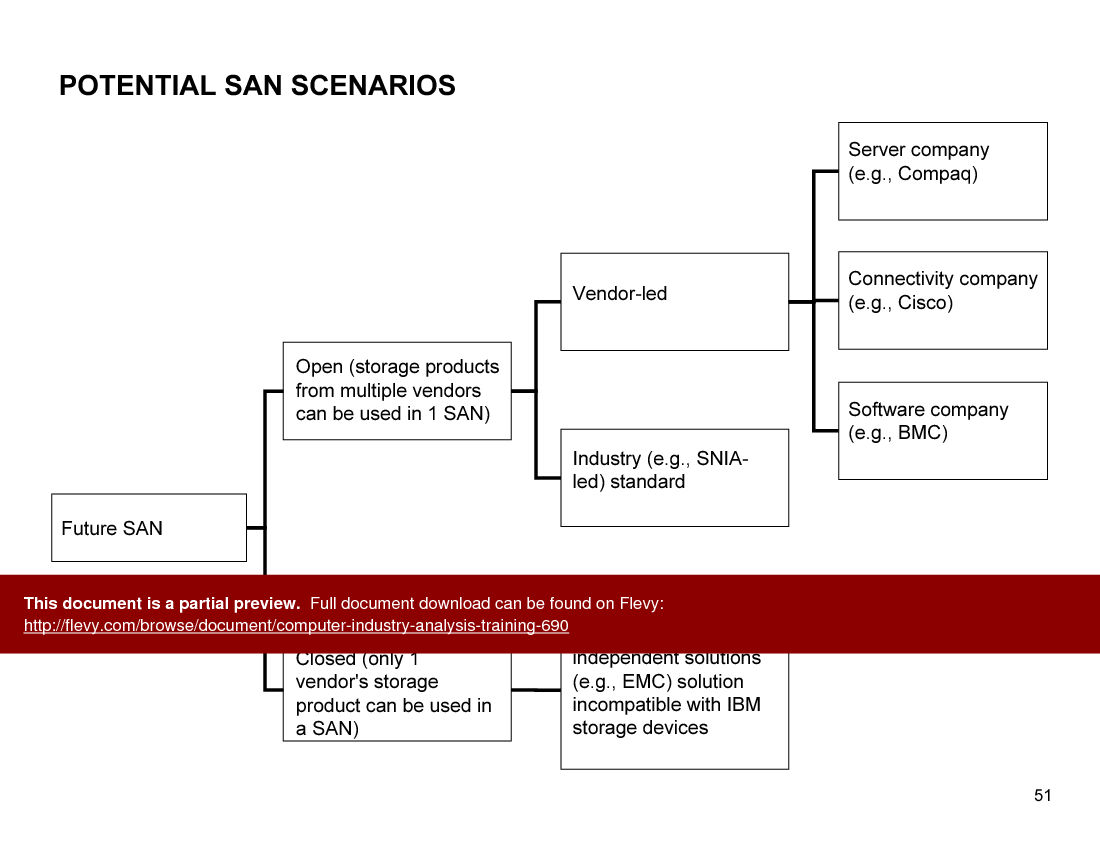
This PPT slide presents a dual analysis of the handheld device market, highlighting both its growth potential and the challenges posed by commoditization. On the left, a bar graph illustrates the significant revenue growth in the handheld device sector from 1999 to 2003, with a compound annual growth rate (CAGR) of 28%. The figures indicate a rise from $6.3 billion in 1999 to $16.9 billion in 2003. This growth is attributed to the strategic importance of handheld devices across various customer segments, particularly in enterprise settings where there is a demand for server functionality and mobile professionals who require access to information on-the-go.
On the right side, another bar graph shows the average selling price (ASP) of these devices, which has experienced a decline, with a CAGR of -11% over the same period. The ASP fell from $761 in 1999 to $475 in 2003. This trend indicates that the market is becoming increasingly competitive and low-margin, suggesting that while the volume of sales may increase, profitability could be under pressure.
The slide concludes with a cautionary note that the handheld device market may not offer significant opportunities for new entrants, as it is characterized by intense competition, established enterprise players, and declining margins. This analysis serves as a critical reminder for potential investors or stakeholders to weigh the growth prospects against the inherent risks of entering a saturated market.
Wireless Infrastructure Advancements for Handheld Devices
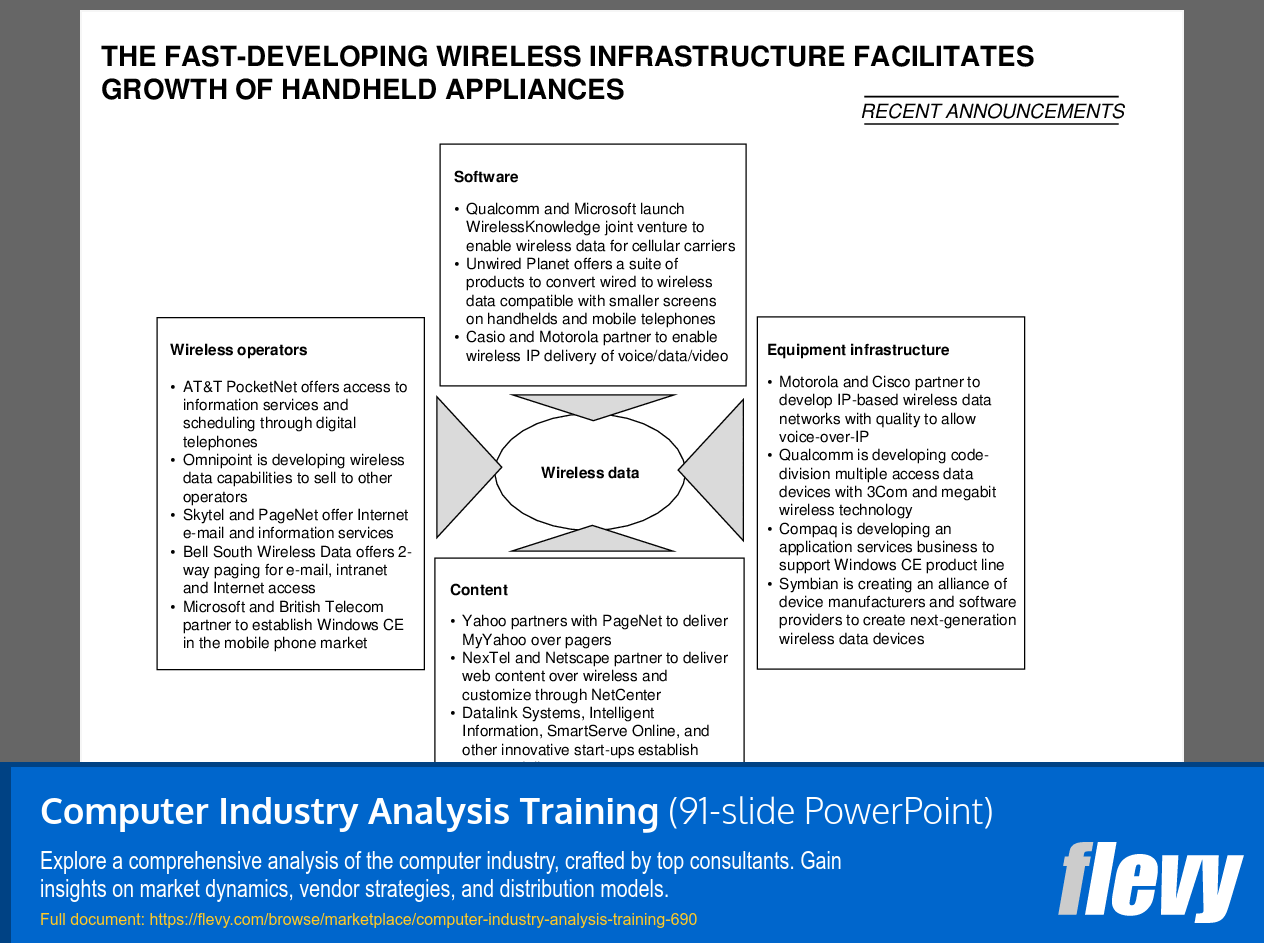
This PPT slide presents a comprehensive overview of the rapidly evolving wireless infrastructure and its impact on the growth of handheld appliances. It is structured into 4 main categories: Wireless Operators, Software, Content, and Equipment Infrastructure, each detailing key players and initiatives within the wireless data ecosystem.
In the Wireless Operators section, several companies are highlighted, including AT&T PocketNet and Omnipoint, which are developing services that enhance access to information and scheduling via digital platforms. This indicates a trend towards increasing connectivity and service offerings in the wireless domain. The mention of Microsoft and British Telecom's partnership to establish Windows CE in the mobile phone market suggests a strategic move to integrate software capabilities with hardware advancements.
The Software segment outlines significant collaborations, such as Qualcomm and Microsoft's joint venture, which aims to facilitate wireless data capabilities for cellular carriers. This partnership reflects a broader trend of integrating software solutions with hardware to optimize performance. Unwired Planet's offerings to convert wired data for smaller screens further emphasize the shift towards accommodating diverse device formats.
Content delivery is also addressed, with partnerships like Yahoo and PageNet working to enhance user experience through wireless web content. This highlights the growing importance of content accessibility on handheld devices.
Lastly, the Equipment Infrastructure section details collaborations between major players like Motorola and Cisco to develop advanced wireless data networks. Qualcomm's initiatives in creating multiple access data devices underscore the drive towards more robust and efficient wireless technologies.
Overall, this slide encapsulates the interconnected nature of wireless data advancements and their implications for the handheld appliance market, making it a valuable resource for stakeholders looking to navigate this dynamic landscape.
EMC's Superior Shareholder Returns Compared to Peers

This PPT slide presents a graphical representation of indexed total returns to shareholders for several prominent companies in the technology sector, specifically focusing on EMC, Dell, Microsoft, and Intel. The timeline spans from December 1989 to the present, with the index set at 1.0 for December 1989.
EMC is highlighted as the leader in high-end systems, showcasing significant growth in shareholder returns, particularly in the latter part of the timeline. The graph illustrates a steep upward trajectory for EMC, indicating a robust performance compared to its peers. The yellow line representing EMC sharply diverges from the other lines, suggesting that it has outperformed its competitors by a considerable margin.
Dell, represented by a dashed yellow line, also shows a notable increase in returns,, but not to the same extent as EMC. The graph indicates that while Dell has experienced growth, it has not matched the stellar performance of EMC.
The lines for Microsoft and Intel, shown in gray and purple respectively, reveal a more modest increase in shareholder returns over the same period. Their trajectories remain relatively flat compared to EMC, suggesting that these companies have not delivered the same level of value to shareholders in the high-end systems market.
This slide effectively communicates the superior performance of EMC in the context of shareholder returns, making it a compelling case for potential investors or stakeholders considering the company's market position and growth potential. The stark contrast in performance among these companies provides valuable insights into their relative market effectiveness and strategic positioning.
Synergistic Core Competencies Driving Customer Loyalty

This PPT slide illustrates how Dell’s core competencies interconnect to enhance overall business performance. At the center, "Customer acquisition & retention" is highlighted as a pivotal element, surrounded by various competencies that contribute to this goal.
The left side emphasizes operational strengths, such as "Efficient direct manufacturing & fulfillment," "High reliability," and "Low cost." These elements suggest that Dell's streamlined processes and cost-effective strategies are foundational to delivering reliable products, which in turn fosters customer loyalty.
On the right side, the slide presents insights and forecasting capabilities. "Customer insights" and "Accurate demand forecast" are crucial for understanding market needs and aligning product offerings accordingly. The "Direct customer interface" reinforces the importance of maintaining open lines of communication with customers, which is essential for gathering feedback and enhancing service.
The slide also notes "Profitable growth" as a key outcome of these interconnected competencies. This indicates that the synergy among these elements not only drives customer satisfaction, but also contributes to financial success.
Consumer retention rates are provided as a comparative metric, showcasing Dell's 83% retention against Compaq's 62%. This statistic underscores the effectiveness of Dell's strategies in building long-term customer relationships.
Overall, the slide effectively communicates that Dell's integrated approach to its core competencies is designed to create a robust framework for customer engagement and sustained profitability. Prospective customers can glean that investing in such a comprehensive strategy may yield significant returns in both customer loyalty and financial performance.
Market Consolidation Trends in Computer Distribution
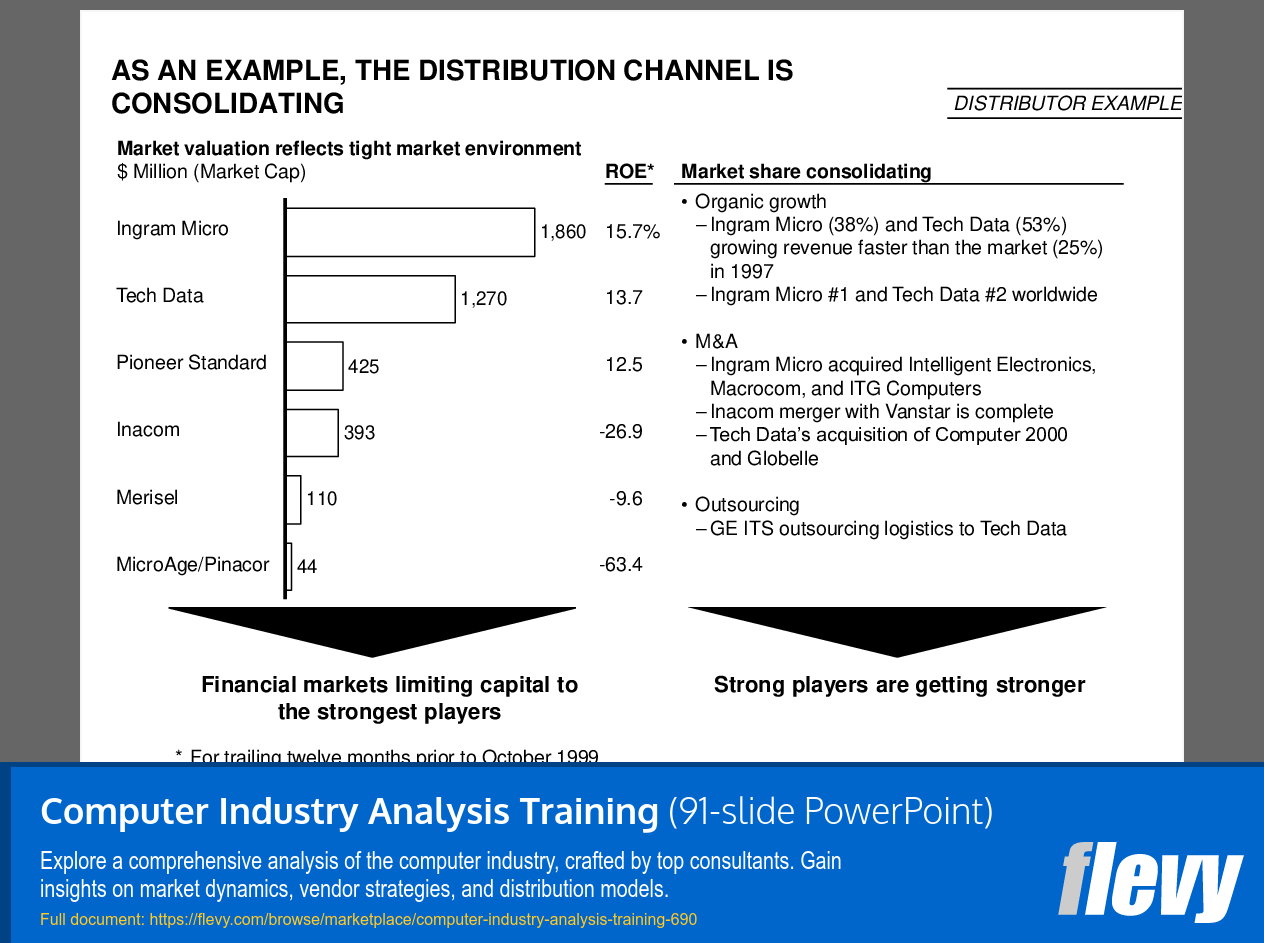
This PPT slide illustrates the consolidation trend within the distribution channel of the computer industry, emphasizing market valuations and return on equity (ROE) among key players. The chart presents market capitalization figures for various companies, with Ingram Micro leading at $1,860 million and a ROE of 15.7%. Tech Data follows with a market cap of $1,270 million and a ROE of 13.7%. The remaining companies, such as Pioneer Standard, Inacom, Merisel, and MicroAge/Pinacor, show significantly lower valuations and some negative ROEs, indicating financial struggles.
The text highlights factors contributing to market share consolidation. Organic growth is noted as a primary driver, with Ingram Micro and Tech Data outperforming the overall market growth rate. Their aggressive revenue strategies have positioned them as leaders in the distribution sector. Mergers and acquisitions (M&A) are also pivotal, with Ingram Micro's acquisitions of several companies and Tech Data's strategic purchases enhancing their market positions.
The slide also points out that financial markets are increasingly favoring stronger players, limiting capital access for weaker firms. This trend underscores a broader industry shift where only the most robust companies can thrive, further entrenching their dominance. The mention of outsourcing, specifically GE ITS's logistics partnership with Tech Data, illustrates additional strategies employed by these firms to bolster their operational efficiency and market presence.
Overall, the slide serves as a critical snapshot of the current state of the distribution channel, providing insights into the dynamics shaping the industry and the implications for potential investors or stakeholders.
Market Growth Driven by Mobile Data Accessibility
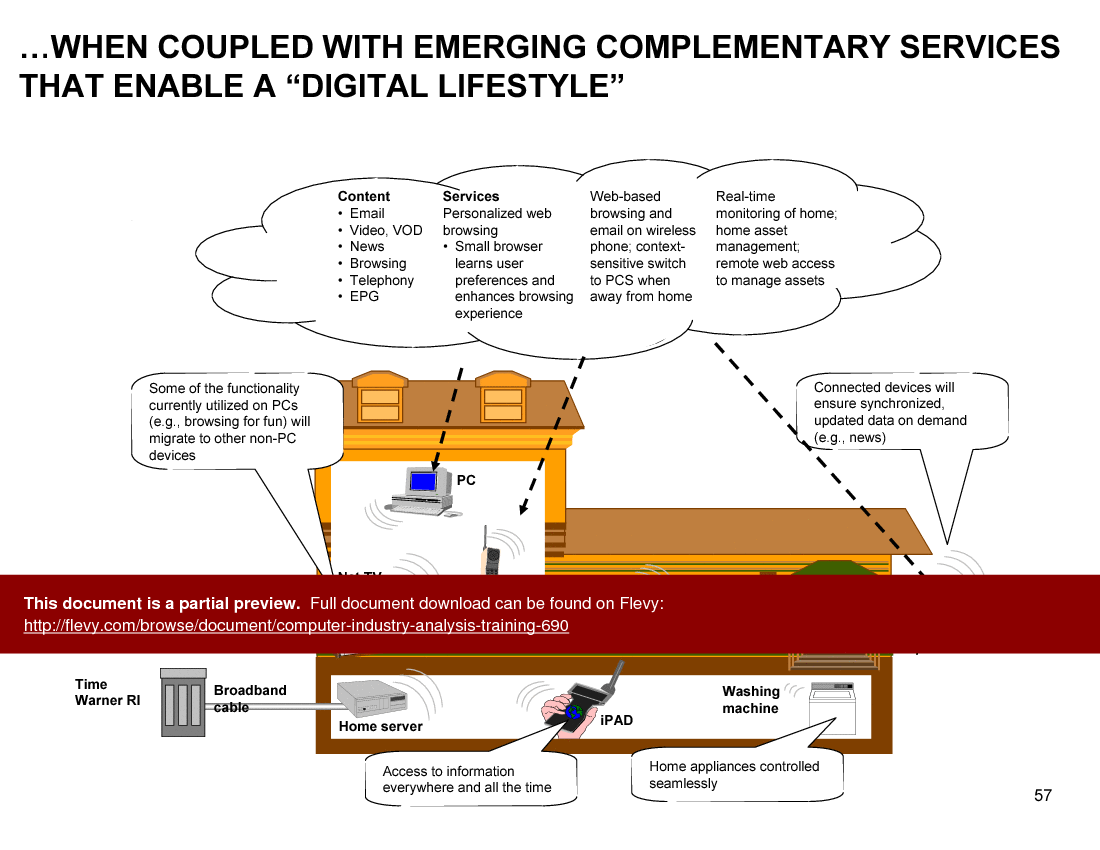
This PPT slide presents an analysis of the declining barriers to mobile data services, highlighting the resultant growth potential in the market. It outlines 3 primary factors: Devices, Applications, and Networks.
Under the "Device" section, it notes the significant number of digital handsets and PDAs expected by 2002, alongside advancements driven by Moore's Law, which enhances device performance and size. This indicates a trend toward greater accessibility and functionality in mobile devices, setting the stage for increased user engagement.
The "Applications" segment emphasizes the shift toward open, Internet-based standards, such as WAP and WML, which facilitate broader application development. The growing trend of web-enabled enterprise applications suggests that businesses are increasingly leveraging mobile technology for operational efficiency. This shift is crucial as it indicates a maturation of mobile applications that can cater to both consumer and enterprise needs.
In the "Network" category, the slide highlights the evolution of networks becoming packet-data capable, which is essential for supporting mobile data services. The mention of technologies like IS95B and GPRS indicates a move toward higher bandwidth capabilities. Additionally, the overall explosion in mobile usage due to declining costs suggests a democratization of access to mobile data services, further fueling market growth.
The revenue estimates presented in the graph illustrate a robust upward trajectory from 1999 to 2003, indicating a significant increase in end-user services revenue. This data reinforces the notion that the mobile data market is not only expanding, but also evolving rapidly, driven by technological advancements and changing user behaviors.
Market Segmentation and Vendor Share in 1998

This PPT slide presents a detailed market segmentation analysis of the PC landscape based on 1998 data, highlighting revenue distribution among various vendors across different server categories. The data is organized into distinct segments: mainframes, midrange servers, entry-level servers, consumer PCs, and commercial PCs.
In the mainframe category, IBM leads significantly with a revenue share of $47 billion, followed by HP, Unisys, Fujitsu, and others, collectively contributing to the remaining market. The midrange server segment shows IBM and HP as the dominant players, with notable contributions from Sun and Compaq.
Entry-level servers reveal a competitive environment, with Compaq holding the largest share at $30 billion, followed by Dell and HP. The consumer PC segment indicates a varied landscape, where Compaq and Packard Bell are key players,, but there’s a notable presence of white box systems, which are less branded and often cheaper alternatives.
The commercial PC segment mirrors the consumer market, with Compaq and Dell again leading, while the presence of white box systems is emphasized. The slide also notes that the PC segment is fragmented, with white boxes occupying a significant market share. This suggests a shift towards commoditization, where brand loyalty may be less critical than price and specifications.
Overall, the slide underscores the dominance of large manufacturers in the server and mainframe markets while illustrating the growing prominence of unbranded systems in the broader PC market. This information is vital for stakeholders considering market entry or investment strategies in the evolving tech landscape.
ABOUT THE AUTHOR
Ask the Author a Question
You must be logged in to contact the author.
|
|
"I have used Flevy services for a number of years and have never, ever been disappointed. As a matter of fact, David and his team continue, time after time, to impress me with their willingness to assist and in the real sense of the word. I have concluded in fact ... [read more] that it is not at all just a repository of documents/resources but, in the way that David and his team manage the firm, it is like dealing with consultants always ready to assist, advise and direct you to what you really need, and they always get it right.
"
I am an international hospitality accomplished senior executive who has worked and lived during the past 35 years in 23 countries in 5 continents and I can humbly say that I know what customer service is, trust me. Aside from the great and professional service that Flevy's team provide, their wide variety of material is of utmost great quality, professionally put together and most current. Well done Flevy, keep up the great work and I look forward to continue working with you in the future and to recommend you to a variety of colleagues around the world. – Roberto Pelliccia, Senior Executive in International Hospitality
|
|
|
"If you are looking for great resources to save time with your business presentations, Flevy is truly a value-added resource. Flevy has done all the work for you and we will continue to utilize Flevy as a source to extract up-to-date information and data for our virtual and onsite presentations!"
– Debbi Saffo, President at The NiKhar Group
|
|
|
"One of the great discoveries that I have made for my business is the Flevy library of training materials.
As a Lean Transformation Expert, I am always making presentations to clients on a variety of topics: Training, Transformation, Total Productive Maintenance, Culture, Coaching, Tools, Leadership Behavior, etc. Flevy ... [read more] usually has just what I need to make my point.
"
It is well worth the money to purchase these presentations. Sure, I have the knowledge and information to make my point. It is another thing to create a presentation that captures what I want to say. Flevy has saved me countless hours of preparation time that is much better spent with implementation that will actually save money for my clients. – Ed Kemmerling, Senior Lean Transformation Expert at PMG
|
|
|
"FlevyPro provides business frameworks from many of the global giants in management consulting that allow you to provide best in class solutions for your clients."
– David Harris, Managing Director at Futures Strategy
|
|
|
"FlevyPro has been a brilliant resource for me, as an independent growth consultant, to access a vast knowledge bank of presentations to support my work with clients. In terms of RoI, the value I received from the very first presentation I downloaded paid for my subscription many times over! The ... [read more] quality of the decks available allows me to punch way above my weight – it's like having the resources of a Big 4 consultancy at your fingertips at a microscopic fraction of the overhead. "
– Roderick Cameron, Founding Partner at SGFE Ltd
|
|
|
"Last Sunday morning, I was diligently working on an important presentation for a client and found myself in need of additional content and suitable templates for various types of graphics. Flevy.com proved to be a treasure trove for both content and design at a reasonable price, considering the time I ... [read more] saved. I encountered a download issue during the ordering process. However, a quick email to Flevy's support team, even on a Sunday (!!!), resulted in assistance within less than an hour, allowing me to download the content I needed. Fantastic job, Flevy! I give 5 stars for both content/price and customer service. Thank you! "
– M. E., Chief Commercial Officer, International Logistics Service Provider
|
|
|
"Flevy is now a part of my business routine. I visit Flevy at least 3 times each month.
Flevy has become my preferred learning source, because what it provides is practical, current, and useful in this era where the business world is being rewritten. In today's environment where there are so ... [read more] many challenges and there is the need to make the right decisions in a short time, with so much scattered information, we are fortunate to have Flevy. Flevy investigates, selects, and puts at our disposal the best of the best to help us be successful in our work. "
– Omar Hernán Montes Parra, CEO at Quantum SFE
|
|
|
"I have used FlevyPro for several business applications. It is a great complement to working with expensive consultants. The quality and effectiveness of the tools are of the highest standards."
– Moritz Bernhoerster, Global Sourcing Director at Fortune 500
|
